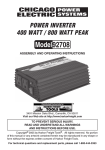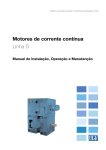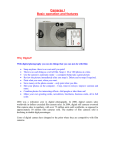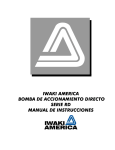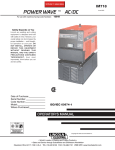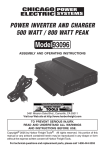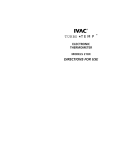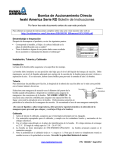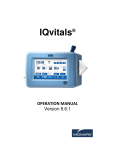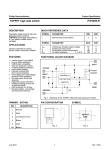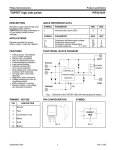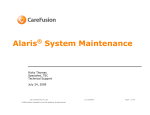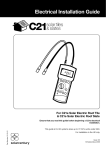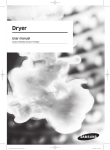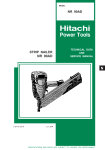Download Tri-Site Technical Service Manual
Transcript
Technical Service Manual Alaris® Tri-Site Thermometer Models 228XXX May 2006 Alaris® Products General Contact Information Cardinal Health Alaris® Products Cardinal Health The Crescent, Jays Close Basingstoke, Hampshire, RG22 4BS, United Kingdom http://www.cardinalhealth.co.uk/alaris 10221 Wateridge Circle San Diego, California 92121 USA http://www.cardinal.com/alaris Customer Advocacy Clinical and technical feedback. North America: Phone: 800.854.7128, Ext. 7812 E-Mail: [email protected] International: E-Mail: [email protected] Technical Support - North America Maintenance, service information support, and troubleshooting. United States: Phone: 858.458.6003 800.854.7128, Ext. 6003 Canada: Phone: Eastern: 800.387.8309 Western: 800.387.8309 Customer Care - North America only Instrument return, service assistance, and order placement. United States: Phone: 800.482.4822 Canada: Phone: 800.387.8309 Technical and Customer Services - UK only Maintenance and service information support. Instrument return, service assistance, and order placement. Customer Service: Freephone: 0800 917 8776 E-Mail: [email protected] Technical Service: Freephone: 0800 389 6972 E-Mail: [email protected] International Service Contacts For service or technical information, contact the nearest Cardinal Health Affiliate Office, your local representative, or see: http://www.alarismed.co.uk/technical/contacts.html Alaris® Tri-Site Thermometer Models 228XXX Technical Service Manual TABLE OF CONTENTS Chapter 1 - General Information 1.1 Introduction . . . . . . . . . . . . . . . . . . . . . . . . . . . . . . . . . . . . . . . . . . . . . . . . . . . . . . . . . . . . . . . . . . . . . . . . . . . . . . . . . . . . . . . . . . . . 1-1 1.2 Warning Definitions . . . . . . . . . . . . . . . . . . . . . . . . . . . . . . . . . . . . . . . . . . . . . . . . . . . . . . . . . . . . . . . . . . . . . . . . . . . . . . . . . . . 1-3 1.3 Specifications 1-3 1.4 Operating Features, Controls and Indicators 1.5 Accessories 1.6 Customer and Technical Service ......................................................................................... ....................................................... 1-3 ........................................................................................... 1-3 .................................................................... 1-3 Chapter 2 - Checkout and Configuration 2.1 Introduction . . . . . . . . . . . . . . . . . . . . . . . . . . . . . . . . . . . . . . . . . . . . . . . . . . . . . . . . . . . . . . . . . . . . . . . . . . . . . . . . . . . . . . . . . . . . 2-1 2.2 New Instrument Checkout 2-1 2.3 Changing Factory Default Settings 2.3.1 Mode and Scale 2.3.2 Anti-Theft Timer Interval ........................................................................... .................................................................. 2-2 ...................................................................................... 2-2 ............................................................................. 2-2 Chapter 3 - Preventive Maintenance 3.1 Introduction . . . . . . . . . . . . . . . . . . . . . . . . . . . . . . . . . . . . . . . . . . . . . . . . . . . . . . . . . . . . . . . . . . . . . . . . . . . . . . . . . . . . . . . . . . . . 3-1 3.2 Preventive Maintenance ............................................................................. 3-1 3.2.1 Visual Inspection . . . . . . . . . . . . . . . . . . . . . . . . . . . . . . . . . . . . . . . . . . . . . . . . . . . . . . . . . . . . . . . . . . . . . . . . . . . . . . . . . . . . . . 3-2 3.2.2 Startup Check . . . . . . . . . . . . . . . . . . . . . . . . . . . . . . . . . . . . . . . . . . . . . . . . . . . . . . . . . . . . . . . . . . . . . . . . . . . . . . . . . . . . . . . . . 3-2 3.2.3 Pulse Timer Check ................................................................................... 3-2 3.2.4 Calibration and Probe Detection Check . . . . . . . . . . . . . . . . . . . . . . . . . . . . . . . . . . . . . . . . . . . . . . . . . . . . . . . . . . . . . 3-3 3.2.5 Probe Simulator Calibration Verification ............................................................ 3-5 3.3 Cleaning ............................................................................................... 3-5 3.3.1 Cleaning Thermometer Buttons ..................................................................... 3-5 4.1 Introduction . . . . . . . . . . . . . . . . . . . . . . . . . . . . . . . . . . . . . . . . . . . . . . . . . . . . . . . . . . . . . . . . . . . . . . . . . . . . . . . . . . . . . . . . . . . . 4-1 4.2 Operation Overview 4-1 4.3 Continuous Measurement Method 4.4 Chapter 4 - Principles of Operation .................................................................................. .................................................................. 4-2 Fast Measurement Method .......................................................................... 4-2 4.5 Thermometer Subsystems ........................................................................... 4-3 4.5.1 Microcomputer ........................................................................................ 4-4 4.5.2 DC Power Regulation 4.5.3 Thermometer Probe Operation ...................................................................... 4-4 4.5.4 Liquid Crystal Display (LCD) Operation . . . . . . . . . . . . . . . . . . . . . . . . . . . . . . . . . . . . . . . . . . . . . . . . . . . . . . . . . . . . . 4-5 4.5.5 Thermometer Audio .................................................................................. 4-5 4.5.6 Anti-Theft Feature .................................................................................... 4-5 ................................................................................ Alaris® Tri-Site Thermometer Models 228XXX Technical Service Manual 4-4 i TABLE OF CONTENTS Chapter 5 - Corrective Maintenance 5.1 Introduction . . . . . . . . . . . . . . . . . . . . . . . . . . . . . . . . . . . . . . . . . . . . . . . . . . . . . . . . . . . . . . . . . . . . . . . . . . . . . . . . . . . . . . . . . . . . 5-1 5.2 Disassembly/Resassembly .......................................................................... 5-2 5.2.1 Opening the Case .................................................................................... 5-3 5.2.2 Anti-Theft Timer Configuration . . . . . . . . . . . . . . . . . . . . . . . . . . . . . . . . . . . . . . . . . . . . . . . . . . . . . . . . . . . . . . . . . . . . . . . 5-4 5.2.3 Circuit Board .......................................................................................... 5-5 5.2.4 Probe Wells ........................................................................................... 5-6 Chapter 6 - Troubleshooting 6.1 Introduction . . . . . . . . . . . . . . . . . . . . . . . . . . . . . . . . . . . . . . . . . . . . . . . . . . . . . . . . . . . . . . . . . . . . . . . . . . . . . . . . . . . . . . . . . . . . 6-1 6.2 Self-Test . . . . . . . . . . . . . . . . . . . . . . . . . . . . . . . . . . . . . . . . . . . . . . . . . . . . . . . . . . . . . . . . . . . . . . . . . . . . . . . . . . . . . . . . . . . . . . . 6-1 Chapter 7 - Illustrated Parts Breakdown ii 7.1 Introduction . . . . . . . . . . . . . . . . . . . . . . . . . . . . . . . . . . . . . . . . . . . . . . . . . . . . . . . . . . . . . . . . . . . . . . . . . . . . . . . . . . . . . . . . . . . . 7-1 7.2 Illustrations ............................................................................................ 7-1 7.3 Parts List .............................................................................................. 7-1 7.4 Ordering Parts ........................................................................................ Alaris® Tri-Site Thermometer Models 228XXX Technical Service Manual 7-1 TABLE OF CONTENTS List of Tables 1-1 Thermometer Models/Versions Covered by this Service Manual 3-1 Probe Simulator Settings/Displayed Temperatures 3-2 Resistance Decade Box/Displayed Temperatures 3-3 Probe Simulator Verification 5-1 Required Materials, Supplies and Tools 5-2 Level of Testing Guidelines 6-1 Technical Troubleshooting Guide 6-2 Error Messages 7-1 Parts List ................................. 1-2 ................................................ 3-3 ................................................. 3-4 ......................................................................... 3-5 ............................................................ 5-2 .......................................................................... 5-7 ................................................................... 6-2 ....................................................................................... 6-5 .............................................................................................. 7-2 List of Figures 3-1 Probe Simulator 3-2 Resistance Decade Box 3-3 Probe Simulator Cable Plug 4-1 Block Diagram 5-1 Opening the Case 5-2 Anti-Theft Jumper Configuration .................................................................... 5-4 5-3 Circuit Board ......................................................................................... 5-5 5-4 Probe Wells .......................................................................................... 5-6 7-1 Label Placement 7-2 Front/Rear Case, Battery Compartment 7-3 Circuit Board Assembly 7-4 Accessories ...................................................................................... ............................................................................. 3-3 3-4 ......................................................................... 3-5 ........................................................................................ 4-3 .................................................................................... ...................................................................................... 5-3 7-4 ............................................................ 7-5 .............................................................................. 7-6 ........................................................................................... 7-7 Alaris® Tri-Site Thermometer Models 228XXX Technical Service Manual iii TABLE OF CONTENTS T H I S PA G E I N T E N T I O N A L LY LEFT BLANK iv Alaris® Tri-Site Thermometer Models 228XXX Technical Service Manual 1 GENERAL INFORMATION Chapter 1 — GENERAL INFORMATION ! ! To avoid damaging the keypad, do not use sharp objects (pens, pencils, etc.) to activate switches. 1.1 Any attempt to service this product by anyone other than an authorized Cardinal Health Service Representative while the product is under warranty may invalidate the warranty. INTRODUCTION This technical service manual describes how to maintain and service the Alaris® Tri-Site thermometer in its North American and International versions. The North American and international versions of the thermometer function identically and require the same maintenance and service. The North American version is labeled in English, and the international version uses icons. The Alaris® Tri-Site thermometer is available in nine models (see Table 1-1) and uses only P850A disposable probe covers. This manual is intended for personnel experienced in analyzing, troubleshooting and repairing analog and digital electronic equipment. The Alaris® Tri-Site thermometer Directions for Use describes how to set up and operate the thermometer. Alaris® Tri-Site thermometer (International version) Alaris® Tri-Site thermometer (North American version) Alaris® Tri-Site Thermometer Models 228XXX Technical Service Manual 1-1 GENERAL INFORMATION 1.1 INTRODUCTION (Continued) The Alaris® Tri-Site thermometer includes a thermometer, a home base, probes, and attachment options. Table 1-1. Thermometer Models/Versions Covered by this Technical Service Manual Model/ version Portable Wall Mount Oral/ Axillary Rectal Only Probe (blue) Probe (red) 2280OR (North America) X X 2280O (North America) X X 2280R (North America) X 2285OR (North America) X X 2285O (North America) X X 2285R (North America) X 2281OR (International) X X 2281O (International) X X 2281R (International) X 1-2 Table 1-1 summarizes thermometer package contents according to model and version: Alaris® Tri-Site Thermometer Models 228XXX Technical Service Manual Home Base Carrying Strap Probe Cover Dispenser X X X X X X X X X X X X X X X X X X X X X X X X X X X X X X GENERAL INFORMATION 1.2 WARNING DEFINITIONS Refer to the Alaris® Tri-Site thermometer DFU. 1.3 SPECIFICATIONS Refer to the Alaris® Tri-Site thermometer DFU. 1.4 OPERATING FEATURES, CONTROLS AND INDICATORS Refer to the Alaris® Tri-Site thermometer DFU. 1.5 ACCESSORIES Refer to the Alaris® Tri-Site thermometer DFU. 1.6 CUSTOMER AND TECHNICAL SERVICE Refer to “General Contact Information” at the front of this manual. Alaris® Tri-Site Thermometer Models 228XXX Technical Service Manual 1-3 GENERAL INFORMATION T H I S PA G E I N T E N T I O N A L LY LEFT BLANK 1-4 Alaris® Tri-Site Thermometer Models 228XXX Technical Service Manual 2 CHECKOUT & CONFIGURATION Chapter 2 — CHECKOUT AND CONFIGURATION 2.1 ! INTRODUCTION This chapter describes initial setup and configuration for the Alaris® Tri-Site thermometer. Due to product changes over time, configurations described in this chapter may differ from the instrument being serviced. Remove the thermometer from use immediately if it is dropped or severely jarred. Qualified service personnel must thoroughly test and inspect the thermometer before returning to use. 2.2 NEW INSTRUMENT CHECKOUT Refer to the thermometer Directions for Use (DFU) for instructions regarding unpacking and setup for first time use. At power up verify the that the thermometer beeps and all LCD elements flash. This confirms that the thermometer has passed its self test and is operating correctly. The thermometer continually performs a self test during operation and alarms and displays a message if it detects an internal malfunction. Alaris® Tri-Site Thermometer Models 228XXX Technical Service Manual 2-1 CHECKOUT AND CONFIGURATION 2.3 CHANGING FACTORY DEFAULT SETTINGS 2.3.1 Mode and Scale The thermometer factory default settings for mode and temperature scale are Fast Oral mode, Fahrenheit (°F) temperature scale. To change the default settings: 1. Press Pulse Timer button for 15 seconds (until LCD display test begins). 2. To change default settings: Press the Mode button until the screen displays the desired mode. Press the Recall/Temperature Scale button until the screen displays the desired temperature scale. 3. Press Pulse Timer button or remove probe from well to save the new default settings. 2.3.2 Anti-Theft Timer Interval Refer to “Anti-Theft Timer Configuration” in Chapter 5 (Corrective Maintenance). 2-2 Alaris® Tri-Site Thermometer Models 228XXX Technical Service Manual ! Thermometer settings revert to default values following battery replacement. Qualified hospital/facility personnel must ensure that hospital-approved default settings are selected. 3 PREVENTIVE MAINTENANCE Chapter 3 — PREVENTIVE MAINTENANCE ! Failure to perform regular and preventive maintenance inspections may result in improper thermometer operation. 3.1 INTRODUCTION Perform regular and preventive maintenance inspections to ensure that the thermometer remains in good operating condition: • Perform regular inspections for damage and cleanliness before each use as described in the Alaris® Tri-Site thermometer DFU. • Perform preventive maintenance inspections annually. These requirements and guidelines are intended to complement the intent of Joint Commission on Accreditation of Healthcare Organizations (JCAHO) requirements. Electrical safety tests are not required for battery-powered devices. 3.2 PREVENTIVE MAINTENANCE Qualified service personnel must perform these periodic maintenance procedures annually: • Visual inspection (section 3.2.1). • Startup check (section 3.2.2). • Pulse timer check (section 3.2.3). • Calibration check (section 3.2.4). • Probe simulator calibration, if applicable (section 3.2.5). Cardinal Health offers service agreements for performing required periodic inspections. 3.2.1 Visual Inspection Check the case, display, and probes for damage and cleanliness. (Section 3.3 describes how to clean the thermometer). Alaris® Tri-Site Thermometer Models 228XXX Technical Service Manual 3-1 PREVENTIVE MAINTENANCE 3.2.2 Startup Check Backlight Test The Startup Check includes a power-on test, functional test, backlight test, and display test. 1. Use black tape to cover hole above LCD. 2. Press and release Pulse Timer button, then verify that backlight is on. Power-On Test 3. Press and release Pulse Timer button again, then verify that backlight is off. 1. Install batteries into thermometer. 2. Verify that the screen displays all segments, then beeps and displays the Return to Base symbol or message. 4. Remove black tape. Display Test 3. Return thermometer to home base. 1. Press and hold Pulse Timer button for 15 seconds, until the LCD displays the software revision. 4. Verify that beeping stops and display is blank. 2. Release Pulse Timer button. Display test begins within 2 seconds: verify that each segment flashes. Functional Test 1. Insert an oral probe into the blue well. Insert the connector into jack #2. 3. Press and briefly hold Pulse Timer button to exit test and turn thermometer off. 2. Remove probe from storage well. 3. Verify that the instrument beeps once and that all segments except the Pulse Timer clock momentarily turn on. Pulse Timer Check 4. When this sequence is complete (1 to 2 seconds), verify that the instrument displays the Fast Oral Mode symbol or message. 1. Press and hold Pulse Timer button for one second. Verify that a short beep sounds and the 12-segment timer symbol appears. 5. Verify that no alarms occur for 10 seconds, then return probe to well. 2. Verify that one segment disappears every five seconds. 6. Verify that thermometer beeps once and display is blank. 3. Verify that thermometer beeps: • once at 15 seconds • twice at 30 seconds • three times at 60 seconds 7. Verify that no alarms occur for 30 seconds (thermometer automatically tests heater interlock circuits). 8. If applicable, repeat procedure for rectal probe (insert into red well and connect to jack #1). 3-2 3.2.3 Alaris® Tri-Site Thermometer Models 228XXX Technical Service Manual 4. Press Pulse Timer button to stop timer operation at any time: verify that thermometer beeps three times and timer symbol turns off. PREVENTIVE MAINTENANCE 3.2.4 Calibration and Probe Detection Check The calibration check verifies that the microprocessor can correctly measure and convert circuit resistance to a temperature value. The probe detection check verifies that the thermometer can detect that the correct probe is in the correct jack. Perform the calibration check using a probe simulator, resistance decade box, or circulating water bath. Perform the probe detection check using a probe simulator or resistance decade box. Figure 3-1. Probe Simulator (Model TE 1811) 5. Set probe simulator to the values listed in Table 3-1, then verify displayed temperatures. 6. Set probe simulator to BP, then press BROKEN PROBE button. Verify that error message 67 appears. 7. Disconnect probe simulator cable. Again verify that thermometer is silent and display is blank. Set thermometer to Rectal Continuous/Monitor mode. 8. Set probe simulator to ORAL and START positions. 9. Connect probe simulator cable to jack #1 (red side), and verify that error message 3 appears. 10. Set probe simulator to RECTAL. 11. Verify that thermometer displays Rectal Continuous/Monitor Mode symbol or message. 12. Set probe simulator to the values listed in Table 3-1, then verify displayed temperatures. Probe Simulator Method 1. Verify that thermometer is silent and display is blank when no probes are connected or installed in wells. Set thermometer to Oral Continuous/Monitor mode. 2. Set probe simulator to RECTAL and START positions. 3. Connect probe simulator cable to jack #2 (blue side), and verify that error message 3 appears. 4. Set probe simulator to ORAL, and verify that thermometer displays Oral Continuous/Monitor Mode symbol or message. Table 3-1. Probe Simulator Settings/ Displayed Temperature Probe Simulator Setting Displayed Temperature 80.2 oF 80.2 ± 0.2 oF or 26.8 ± 0.1 oC 98.0 oF 98.0 ± 0.2 oF or 36.7 ± 0.1 oC 98.6 oF 98.6 ± 0.2 oF or 37.0 ± 0.1 oC 102.0 oF 102.0 ± 0.2 oF or 38.9 ± 0.1 oC 107.8 oF 107.8 ± 0.2 oF or 42.1 ± 0.1 oC Alaris® Tri-Site Thermometer Models 228XXX Technical Service Manual 3-3 PREVENTIVE MAINTENANCE 3.2.4 Calibration and Probe Detection Check (Continued) Probe Simulator Method (Continued) 13. Set probe simulator to BP, then press BROKEN PROBE button. Verify that error message 68 appears. Table 3-2. Resistance Decade Box/ Displayed Temperature Resistance Setting Displayed Temperature 6097 Ω 98.0 ± 0.2 oF or 36.7 ± 0.1 oC 9254 Ω 80.2 ± 0.2 oF or 26.8 ± 0.1 oC 6015 Ω 98.6 ± 0.2 oF or 37.0 ± 0.1 oC 5570 Ω 102.0 ± 0.2 oF or 38.9 ± 0.1 oC 4895 Ω 107.8 ± 0.2 oF or 42.1 ± 0.1 oC 14. Disconnect probe simulator cable. Resistance Decade Box Method 1. Connect the resistance decade box as shown in Figure 3-2. Figure 3-2. Resistance Decade Box 5. Set the resistance decade box to a value greater than 1 MΩ and verify that error message 67 appears. 6. Disconnect probe simulator cable. Again verify that thermometer is silent and display is blank. Set thermometer to Rectal Continuous/Monitor mode. 2. Verify that thermometer is silent and display is blank when no probes are connected or installed in wells. Set thermometer to Oral Continuous/Monitor mode. 3. Connect resistance decade box cable to jack #2 (blue side), and verify that thermometer beeps and displays Oral Monitor/Continuous Mode message or icon. 4. Set resistance decade box to the values listed in Table 3-2, then verify displayed temperatures. 3-4 Alaris® Tri-Site Thermometer Models 228XXX Technical Service Manual 7. Connect jumper between connector pins 1 and 6, then connect cable to jack #1 (red side). 8. Set resistance decade box to the values listed in Table 3-2, then verify displayed temperatures. 9. Set the resistance decade box to a value greater than 1 MΩ and verify that error message 68 appears. PREVENTIVE MAINTENANCE 3.2.4 Calibration and Probe Detection Check (Continued) 3. The probe simulator fails if measured values are not within specified ranges. Circulating Water Bath Method 1. While pressing and holding the pulse timer button, remove a probe from the probe well. Release the pulse timer button. Table 3-3. Probe Simulator Verification Probe Simulator Setting Multimeter Reading 80.2 9250 to 9258 98.0 6093 to 6101 98.6 6011 to 6019 102.0 5566 to 5574 107.8 4891 to 4899 BP and BROKEN PROBE button pressed Open circuit 2. Verify that thermometer displays Oral or Rectal Continuous/Monitor Mode symbol or message. 3. Install a probe cover over the probe and insert the probe 2.5 to 3 inches into water bath. 4. Leave probe in place for at least two minutes. 3.3 5. Verify that displayed temperature is within ±0.2 oF (±0.1 oC ) of actual water temperature. 3.2.5 Probe Simulator Calibration Verification Verify calibration of the probe simulator (if used) annually. Verification requires a FLUKE Multimeter Model 8800A or equivalent 5 1/2 digit meter. 1. Set multimeter to K OHMS, RANGE 20. 2. Measure between pins 2 and 3 of the probe simulator plug (Figure 3-3), then verify resistance measurements (Table 3-3). Figure 3-3. Probe Simulator Cable Plug CLEANING Qualified service personnel must clean thermometer buttons as required. Refer to the Alaris® Tri-Site thermometer DFU for all other cleaning instructions. 3.3.1 Cleaning Thermometer Buttons Clean thermometer buttons periodically: dried matter under buttons can affect response to button presses. To clean button pad: 1. Remove batteries and screws that attach front and back of thermometer, then remove front case. 2. Gently remove button pad from front case, and inspect for damage. If any damage is visible, replace before returning device to use. 3. Use an approved cleaning solution to clean as necessary. 4. Reassemble button pad into front case, align locator pins and cutouts to ensure correct position. 5. Replace screws to attach front and back of thermometer, then replace batteries. Alaris® Tri-Site Thermometer Models 228XXX Technical Service Manual 3-5 PREVENTIVE MAINTENANCE T H I S PA G E I N T E N T I O N A L LY LEFT BLANK 3-6 Alaris® Tri-Site Thermometer Models 228XXX Technical Service Manual 4 PRINCIPLES OF OPERATION Chapter 4 — PRINCIPLES OF OPERATION 4.1 INTRODUCTION This chapter describes the principles of operation for the Alaris® Tri-Site thermometer and its major subsystems. 4.2 OPERATION OVERVIEW The Alaris® Tri-Site thermometer uses a thermistor in the tip of the probe to sense temperature. Temperature changes cause an inverse, nonlinear change in thermistor resistance. The thermistor’s output voltage represents the measured temperature, and is fed to the thermometer’s microcomputer. The microcomputer then drives the thermometer screen to display the temperature. Temperature calculations differ according to whether the Continuous or Fast (predictive) method is in use. Either method can be used at any of three body sites (oral, axillary, or rectal). The combination of measurement method and body site is called the mode. System power up begins when batteries are installed in the thermometer (once batteries are installed, the thermometer alarms until it is returned to home base).The thermometer performs self tests of its RAM, ROM, LCD, reference voltages, audio system, battery voltage, and anti-theft feature. If self testing does not complete within an expected time limit, the thermometer alarms. Once self testing is complete, the thermometer continuously checks its status and alarms if an error is detected. Operator inputs to the thermometer include button presses, connecting probes to the thermometer, and installing and removing probes. Alaris® Tri-Site Thermometer Models 228XXX Technical Service Manual 4-1 PRINCIPLES OF OPERATION 4.3 CONTINUOUS MEASUREMENT METHOD During the Continuous measurement method, the thermometer’s microcomputer converts data from the probe directly to a temperature and displays it in the selected temperature scale (celsius or fahrenheit). A continuous temperature reading generally takes 3 - 5 minutes to stabilize, and the displayed temperature reflects the current measurement as long as the probe is not in its probe well. This method is used for continuous temperature measurements that last less than an hour, or when the thermometer cannot calculate a temperature using the Fast method. 4.4 FAST MEASUREMENT METHOD During the Fast (predictive) measurement method, the thermometer applies power to a heating element in the probe tip to allow the probe to reach a predefined target temperature that is close to the temperature at the body site. The thermometer’s first measurement verifies that ambient temperature is within the specified operating range (16.0 to 33.3°C or 60.8 to 92°F). If not, the thermometer exits the Fast method and uses the Continuous method. 4-2 Alaris® Tri-Site Thermometer Models 228XXX Technical Service Manual If the thermometer switches to the Continuous method, one long beep and a changed mode indicator signal the change. The thermometer also uses the Continuous method if the final predicted temperature is below 35°C (95°F) or above 41°C (106°F), or if it cannot complete the temperature prediction within 22 seconds (oral/rectal temperatures) or 30 seconds (axillary temperatures). When probe temperature reaches 34°C (94°F), the thermometer assumes that tissue contact is established and displays the tissue contact indicator. When probe temperature rises above the predefined target, the heater shuts off. Once the heater shuts off, the thermometer computes an estimate of the steady state temperature by sampling temperature every 100 milliseconds and comparing it to a theoretical curve. This technique allows the Fast method to estimate a temperature within seconds, without having to wait several minutes for the probe's thermistor tip to reach the same temperature as the tissue. When the thermometer reaches a final estimate, it beeps three times and displays the temperature for 45 seconds or until the probe is reinserted into its well. PRINCIPLES OF OPERATION 4.5 THERMOMETER SUBSYSTEMS This section describes subsystems of the Alaris® Tri-Site thermometer, including microcomputer, DC power regulation, probe, LCD, audio, and anti-theft timer. Figure 4-1 shows a block diagram of the thermometer. Figure 4-1. Block Diagram Y1 32.768kHz Y2 5.00MHz U9 5 Volt Boost Converter SHUTDOWN3* +5 V VBATT D3 Q1 V BATT RESET* +5vsw +5 V System Reset U8 CR2 Not Installed SHUTDOWN2 U5 5 Volt Boost Converter 3 AA Cells SHUTDOWN1 Anti-Theft Sensor S3 ANTI_THEFT_REED N S BATT_MONITOR +5vsw SCLK Probe A/D Converter U7 THERMISTOR1 +5vsw ADC_CLK ADC_DATA_IN ADC_DATA_OUT VREF2.50 THERMISTOR2 Ambient Light Detector LDR1 AMBIENT_LIGHT ADC_DATA_RDY* VREF 2.5 vdc VREF2.50 Function Array PROBE_INSTALLED1 PROBE_INSTALLED2 Rectal Probe uCONTROLLER HEATER_PWM HEATER1_ENABLE U6 +5vsw HEATER2_ENABLE LCD Bias Network RE_TRIGGER1 Probe Interface U2,U3 RE_TRIGGER2 HEATER_DETECT LED Backlight DS2 HEATER_DR (Not Used) BACKLIGHT_STROBE Oral Probe Backlight Driver Q4 +5 V Pulse Timer HEATER_DR2 S0 - S22 Liquid Crystal Display DS1 PULSE_TIMER o HEATER_DETECT TEMP_SCALE HEATER_DR1 Probe 'InWell' Detection S4,S5 C/o F PROBE_WELL_RECTAL Mode BUZZER MODE PROBE_WELL_ORAL COM0 - COM2 Audio Driver & Divide by 2 U4 Alaris® Tri-Site Thermometer Models 228XXX Technical Service Manual 4-3 PRINCIPLES OF OPERATION 4.5 4.5.1 THERMOMETER SUBSYSTEMS (Continued) Microcomputer The microcomputer controls all thermometer functions. It is powered whenever the batteries are installed and operates in awake or sleep states. The thermometer measures temperatures and operates the pulse timer in the awake state. The thermometer is partially shut down in the sleep state to conserve power. Pressing a button or removing a probe from its well puts the microcomputer into the awake state. The microcomputer controls the LCD and monitors the voltages that maintain DC power, detect probe(s) installed, LCD backlight operation, and probe heating. Installing batteries resets the microcomputer, which causes the thermometer to revert to its default settings. 4.5.2 DC Power Regulation The thermometer is designed to operate on three AA alkaline batteries, and includes circuitry that supplies a regulated 5 V DC to the device. During the sleep state, the thermometer only supplies enough voltage to power essential circuits. The microcomputer monitors battery voltage and activates the low battery alarm indicator when battery voltage drops to 3.5 V. If battery voltage drops to 3.1 V, temperature measurement stops and the microcomputer activates the replace battery indicator. 4-4 Alaris® Tri-Site Thermometer Models 228XXX Technical Service Manual 4.5.3 Thermometer Probe Operation Thermometer probes include an internal thermistor and heater element. The heater preheats the probe tip to a predefined target temperature when the Fast measurement method is in use. The microcomputer uses a closed loop circuit to control probe heating. The resistance of the probe thermistor varies, according to temperature. The microcomputer uses input voltages from the the thermistor and heater (if used) to compute temperature. Signals from the probes allow the microcomputer to determine the probe type (oral/axillary or rectal), whether the probe is properly connected, and to prevent heater runaway. If a software or microcomputer failure occurs, hardware watchdog circuitry protects heater elements from being overdriven. The microcomputer must continuously activate certain signals for the heater elements to remain on. Without these signals, watchdog circuitry blocks heater element operation. The thermometer activates a broken probe alarm if the measured temperature is below 0°C (32°F) or above 260°C (500°F). The thermometer activates an overheated probe alarm if the measured temperature is over 46°C (115°F). PRINCIPLES OF OPERATION 4.5.4 Liquid Crystal Display (LCD) Operation The microcomputer controls the LCD by multiplexing voltages applied to segment pins with serial port states to turn display segments on and off. A cadmium-sulfide cell whose voltage varies according to light detection acts as an ambient light sensor. The microcomputer monitors light sensor voltage and turns the display backlight (two LEDs) on and off. 4.5.5 Thermometer Audio When an audio tone is required (an indicator beep or continuous alarm tone), the microcomputer generates a signal that activates the speaker. 4.5.6 Anti-Theft Feature The thermometer is designed to alarm and stop operating if it is not returned to its home base within the required time frame. The factory default setting for the anti-theft timer interval is 8 hours. However, the timer can also be configured for 1 hour or timer off (refer to “Anti-Theft Timer Configuration” in Chapter 5, Corrective Maintenance). Removing the batteries does not reset the anti-theft timer. A magnet embedded in the home base closes a switch in the thermometer. Removing the thermometer from home base opens the magnetic switch and starts a countdown timer. Returning the thermometer to its home base closes the switch and resets the timer. For the default configuration of 8 hours, the microcomputer activates the return to home base indicator when about 1 hour of the anti-theft interval remains (that is, after about seven hours have elapsed). If the timer is configured for 1 hour, the return to home base indicator appears when 10 minutes of the interval remains. If the thermometer is not returned to home base before the interval expires, the anti-theft alarm activates and temperature measurement is disabled until the thermometer is returned to base. Returning the thermometer to home base cancels the alarm and resets the timer. Alaris® Tri-Site Thermometer Models 228XXX Technical Service Manual 4-5 PRINCIPLES OF OPERATION T H I S PA G E I N T E N T I O N A L LY LEFT BLANK 4-6 Alaris® Tri-Site Thermometer Models 228XXX Technical Service Manual 5 CORRECTIVE MAINTENANCE Chapter 5 — CORRECTIVE MAINTENANCE ! ! ! CMOS devices are sensitive to static electrical charges and may be damaged during repair if the repair activity is not performed in an electrostatic discharge (ESD) protected environment using approved ESD protective procedures, including personnel grounding. Any attempt to service this product by anyone other than an authorized Cardinal Health Service Representative while the product is under warranty may invalidate the warranty. Due to product changes over time, components/ assemblies illustrated in this chapter may differ from the instrument you disassemble. If there are any questions, look for Service Bulletins related to this chapter or contact Cardinal Health Technical Support. To avoid the risk of electrical hazard or damage to circuitry, do not spray fluids directly onto the instrument or allow fluids to enter the instrument. 5.1 INTRODUCTION This chapter describes how to configure, disassemble, and reassemble the Alaris® Tri-Site thermometer . The components on the circuit board are not field repairable. Return circuit boards to an authorized Cardinal Health Service Center for repair. Attempting circuit board repairs voids all warranties. For more efficient repair, read Chapter 4 (Principles of Operation) for information on the thermometer. For troubleshooting information, read Chapter 6 (Troubleshooting). For information on replacement parts, read Chapter 7 (Illustrated Parts Breakdown). Following any level of maintenance or repair, perform the applicable tests (refer to “Level of Testing Guidelines” table at the end of this chapter). Alaris® Tri-Site Thermometer Models 228XXX Technical Service Manual 5-1 CORRECTIVE MAINTENANCE 5.2 DISASSEMBLY/REASSEMBLY Follow these procedures in order for the most efficient disassembly. To reassemble the thermometer, reverse the disassembly steps. Before adhering gaskets and labels to the instrument, clean the surface with a cotton swab or soft cloth lightly dampened with 70% isopropyl alcohol. Table 5-1. Required Materials, Supplies and Tools • Phillips screwdriver set 5-2 Alaris® Tri-Site Thermometer Models 228XXX Technical Service Manual CORRECTIVE MAINTENANCE 5.2 DISASSEMBLY/REASSEMBLY (Continued) 5.2.1 Opening the Case 4. Remove batteries. 1. Remove probe cover box. 5. Remove battery jumper. 2. Disconnect probes and remove from thermometer. 6. Remove the 2 screws at the top rear of the case and 1 screw at battery compartment. 3. Remove battery cover: squeeze on one side, then the other, to unlock battery cover from case (Figure 5-1). 7. Separate front and back case. The circuit board is attached to the front case. Figure 5-1. Opening the Case Battery cover: squeeze both sides to remove Remove battery contacts to access battery compartment screw Compress battery contact when separating front and back case Alaris® Tri-Site Thermometer Models 228XXX Technical Service Manual 5-3 CORRECTIVE MAINTENANCE 5.2 DISASSEMBLY/REASSEMBLY (Continued) 5.2.2 Anti-Theft Timer Configuration With the case open and circuit board accessible, install jumpers to configure the Anti-Theft Timer (Figure 5-2). Figure 5-2. Anti-Theft Jumper Configuration O = no jumper X = jumper installed E1 E2 E5 Anti-theft interval: 1 hour O X Anti-theft interval: 8 hours X X O O X O Top Side Shown Anti-theft alarm disabled Jumper E5 Jumper E1 5-4 Jumper E2 Alaris® Tri-Site Thermometer Models 228XXX Technical Service Manual Alarm audio: 3 beeps O Alarm audio: continuous X CORRECTIVE MAINTENANCE 5.2 DISASSEMBLY/REASSEMBLY (Continued) 5.2.3 Circuit Board 1. Remove 5 screws and washers that hold the circuit board to the front case (Figure 5-3). 2. Gently rock the circuit board loose from the front case. Figure 5-3. Circuit Board Alaris® Tri-Site Thermometer Models 228XXX Technical Service Manual 5-5 CORRECTIVE MAINTENANCE 5.2 DISASSEMBLY/REASSEMBLY (Continued) 5.2.4 Probe Wells 1. Each well has locking latch that holds it in place (Figure 5-4). 2. Use a tool that can reach under each probe well to release locking latch: slide the well from the rear case while pressing the latch. Figure 5-4. Probe Wells Press locking latch under probe well 5-6 Alaris® Tri-Site Thermometer Models 228XXX Technical Service Manual CORRECTIVE MAINTENANCE 5.2 DISASSEMBLY/REASSEMBLY (Continued) Level of Testing Guidelines Circuit Board Replacement X X X Front/Rear Case Replacement X X Probe Replacement X Preventive Maintenance X X X X X Thermometer Dropped X X X X X Cleaning Calibration Check X Startup Check Battery Replacement Service Procedure Visual Inspection Pulse Timer Check Tests to Perform Table 5-2. Alaris® Tri-Site Thermometer Models 228XXX Technical Service Manual 5-7 CORRECTIVE MAINTENANCE T H I S PA G E I N T E N T I O N A L LY LEFT BLANK 5-8 Alaris® Tri-Site Thermometer Models 228XXX Technical Service Manual 6 TROUBLESHOOTING Chapter 6 — TROUBLESHOOTING ! Because circuit board components are not field serviceable, this manual does not include schematics. 6.1 INTRODUCTION This chapter describes possible technical problems and operating errors that may occur while using the Alaris® Tri-Site thermometer. Refer to this chapter before attempting to service the thermometer. If a problem occurs, first check that: • The thermometer is being operated correctly (according to the DFU). • Batteries are installed correctly and do not need to be replaced. • The anti-theft timer interval has not expired. 6.2 SELF-TEST The thermometer performs self tests every time it is used and whenever the batteries are replaced. If an error is detected, an error code appears and the thermometer stops working. Tables 6-1 and 6-2 describe how to resolve operating problems and error codes. Alaris® Tri-Site Thermometer Models 228XXX Technical Service Manual 6-1 TROUBLESHOOTING Table 6-1. Technical Troubleshooting Guide Follow the steps in the order they are listed until the problem/fault is corrected. Problem Possible Cause Solution Thermometer inoperative, Improperly installed, depleted, or no apparent power. missing batteries. Faulty battery contacts. Short circuit on circuit board. 1. Check battery orientation. 2. Repair or clean battery contacts. 3. Replace batteries. 4. Replace circuit board. Thermometer inoperative, Improper CPU reset. power present on circuit board. 1. Remove and replace batteries. 2. Replace circuit board. Thermometer unexpectedly resets. Intermittent battery contact. 1. Verify correct battery installation. 2. Repair or clean battery contacts. Short battery life. Excessive backlight usage. Short in battery holder. Thermometer operating during storage. 1. Verify that thermometer is not stored in an active or alarm state. 2. Repair or clean battery contacts. 3. Perform Startup Check Backlight Test (see Preventive Maintenance, Chapter 3). 4. Remove batteries when storing thermometer for extended periods. Error message appears. Thermometer error detected. See Table 6-2. Low Battery/Replace Faulty reference voltage or CPU. Battery symbol/message, but batteries are good. Replace circuit board. Thermometer does not respond. Faulty CPU or circuit board connections. 1. Verify CPU and circuit board connections. 2. Replace circuit board. Missing or faint display segments. Faulty LCD or circuit board connections. 1. Verify CPU and circuit board connections. 2. Replace circuit board. 6-2 Alaris® Tri-Site Thermometer Models 228XXX Technical Service Manual TROUBLESHOOTING Table 6-1. Technical Troubleshooting Guide (Continued) Problem Possible Cause Solution Backlight does not function correctly. Faulty backlight or light sensor. Replace circuit board. Beeper does not function correctly. Faulty speaker or speaker drive circuitry. Replace circuit board. Thermometer enters Inadequate tissue contact, initial 1. Allow probe to cool before use. Continuous/Monitor mode probe temperature too high, 2. Verify that buttons are clean and unexpectedly. defective heater element in probe can move freely. tip, stuck Mode button. 3. Replace probe. Return to Base message or symbol does not reset when thermometer returned to home base. Defective magnet in home base, incorrect jumper configuration on circuit board, defective circuit board. 1. Try another home base. 2. Check circuit board jumpers E1 and E2. 3. Replace circuit board. Broken probe indicator, but probe is good. Ambient temperature out of specified operating range, defective circuit board. 1. Verify that ambient temperature is within specified range. 2. Replace circuit board. Out of specification Defective probe or circuit board. readings in Continuos/ Monitor mode using water bath. 1. Replace probe. 2. Perform Calibration Check (see Preventive Maintenance, Chapter 3) Pulse Timer does not work or difficult to start. 1. 2. 3. 4. 5. Anti-theft timer has expired, thermometer in an alarm state, probe not returned to well within 5 minutes of temperature measurement, or defective Pulse Timer button. Return probe to well. Return thermometer to home base. Clear any alarms. Replace front case assembly. Replace circuit board. Alaris® Tri-Site Thermometer Models 228XXX Technical Service Manual 6-3 TROUBLESHOOTING Table 6-1. Technical Troubleshooting Guide (Continued) Problem Temperature Recall does not work. Possible Cause Most recent temperature measurement was not in Fast mode, defective Recall/Scale button. Solution 1. Verify that most recent temperature measurement was in Fast mode. 2. Replace front panel. Removing probe from well Probe not fully inserted into well, does not start thermometer in an alarm state, thermometer. defective probe, well, or switch. 1. Verify that probe is fully inserted into well. 2. Clear any alarms. 3. Replace probe. 4. Replace well. 5. Replace circuit board. Returning probe to well does not deactivate thermometer. Probe not fully inserted into well, thermometer in an alarm state, anti-theft alarm active, defective probe, well, or switch. 1. Verify that probe is fully inserted into well. 2. Return thermometer to home base. 3. Clear any alarms. 4. Replace probe. 5. Replace well. 6. Replace circuit board. Calibration check failure. Defective probe simulator or thermometer. 1. Verify that probe connection and jack are clean. 2. Replace probe. 3. Replace probe simulator, if used. 4. Replace circuit board. 6-4 Alaris® Tri-Site Thermometer Models 228XXX Technical Service Manual TROUBLESHOOTING Table 6-2. Error Messages Error Message Possible Cause Solution 1 Both probes removed from storage wells: Replace at least one probe to storage the thermometer does not operate with both well or disconnect probe from back of probes removed. thermometer. 2 Incorrect probe inserted into well (blue probe in red well or red probe in blue well) Broken or disconnected probe inserted into one well while the other probe is connected but not in its well. Check that probes are inserted into correct wells and that probes are securely connected to jacks. 3 Probe connected to incorrect jack. Check that oral (blue) probe is connected to jack #2 and that rectal (red) probe is connected to jack #1. 4 One or both probes are inserted in wells but Check that probes are connected to connectors are not connected to jacks, or correct jacks. If problem persists, try broken probe(s). replacing probe(s). 67 Broken oral (blue) probe detected. Replace oral probe. 68 Broken rectal (red) probe detected. Replace rectal probe 69 Reference voltages from analog to digital converter (ADD) out of tolerance. Replace circuit board. 70 ADD calibration phase timeout. Replace circuit board. 72 RAM test failure. Replace circuit board. 73 ROM CRC failure. Replace circuit board. 74 Heater interlock fault or defective probe. Replace probe. If problem persists, replace circuit board. 75 Internal fault. Replace circuit board. Alaris® Tri-Site Thermometer Models 228XXX Technical Service Manual 6-5 TROUBLESHOOTING T H I S PA G E I N T E N T I O N A L LY LEFT BLANK 6-6 Alaris® Tri-Site Thermometer Models 228XXX Technical Service Manual 7 ILLUSTRATED PARTS BREAKDOWN Chapter 7 — ILLUSTRATED PARTS BREAKDOWN 7.1 INTRODUCTION The illustrated parts breakdown for the Alaris® Tri-Site thermometer shows its major assemblies. 7.2 ILLUSTRATIONS Use the exploded views to identify the parts of each assembly. Item numbers (the numbers in bubbles) in the illustration correspond to the item number in the parts list. A part that does not have an item number is part of a higher assembly. NOTE: Due to product changes over time, illustrations in this chapter can differ from the instrument under service. See applicable Service Bulletins or contact Cardinal Health Technical Support for more information. 7.3 PARTS LIST The parts lists include the following information for replaceable parts : • Item: This number corresponds to the item number in the illustration. 7.4 • Description: Description of the part. • QTY: Total number of each item used. ORDERING PARTS Parts can be ordered by writing or calling Cardinal Health Customer Service (refer to "General Contract Information" page at beginning of this manual). When requesting a part, provide the following information: • Instrument name and model number; for example, “Tri-Site 2280OR.” • Part description, as provided in parts list. Alaris® Tri-Site Thermometer Models 228XXX Technical Service Manual 7-1 ILLUSTRATED PARTS BREAKDOWN Table 7-1. Parts List Item 2 Description Case Assembly, Front/Label, Tri-Site QTY 1 North America International 17 Screw, TPG, #4-20 x 1.23 PNH PHL 2 18 Screw, TPG, #4-20, 0.625 PNH PHH 1 33 Gasket, Tri-Site 1 34 Circuit Board Assembly 1 North America International 36 Wrench, Hex, 5/64 ACR FL (P/N 301485) 1 37 Washer, Flat, 0.146 x 0.270 x 0.032 Fiber 5 38 Screw, TPG, #4-20 x 0.25, PNH PHH 4 39 Screw, Trilob, #4-20 x 5/16 PHL PNH ZPL 1 44 Case Assembly, Rear, Tri-Site 1 45 Well, Probe, Oral 1 52 Jumper, Battery 228X 2 61 Strap, Carrying, 2X8X (P/N 122854) 1 63 Well, Probe, Rectal 1 65 Pad, Mounting, Foam/Dbl Adh (P/N 127842) 1 66 Cover, Battery, 2X8X 1 67 Screw, TPB, 8 x 3/4 PNH PHH 4 68 Screw, Anchor, 8-10 x 7/8 4 69 Battery, Alkaline, Size AA (P/N 303590) 3 96 Label 1 Sublingual Pocket, Model 2117/2118 Oral Probe Placement International 7-2 Alaris® Tri-Site Thermometer Models 228XXX Technical Service Manual ILLUSTRATED PARTS BREAKDOWN Table 7-1. Parts List (Continued) Item 97 Description Label, Home Base QTY 1 Portable Tri-Site Alaris Tri-Site 98 Home Base 1 (P/N 2117) (P/N 2118) 100 Holder, Probe Cover Box, 2X85 (P/N 134994) 1 101 Washer, 2X85 (part of Item 100) 1 102 Pad, Foam, 2X85 (part of Item 100) 1 607 Directions for Use (DFU), Tri-Site (included in Service Manual Assembly) 1 608 Label, Operating Instructions, Tri-Site 1 Portable, English Portable, International Wall Mount, English 635 Label, Name Rating, Tri-Site 1 English International 636 Label, Battery Replacement, Tri-Site, International 1 642 Label, Anti-Theft, English (North America only) 1 650 Label, Serial Number 1 712 Probe, Tri-Site, Oral, Long (Model 3887) 1 713 Probe, Tri-Site, Rectal, Long (Model 4888) 1 714 Bracket, Probe Cover Dispenser (P/N 896) 1 Probe Simulator (P/N TE 1811) 1 Alaris® Tri-Site Thermometer Models 228XXX Technical Service Manual 7-3 ILLUSTRATED PARTS BREAKDOWN Figure 7-1. Label Placement 650 96 608 635 636 Home Base 7-4 Side 97 Alaris® Tri-Site Thermometer Models 228XXX Technical Service Manual Back Inside Battery Cover ILLUSTRATED PARTS BREAKDOWN Figure 7-2. Front/Rear Case, Battery Compartment 2 44 17 (x2) 18 66 Battery Compartment 52 52 Battery Compartment Alaris® Tri-Site Thermometer Models 228XXX Technical Service Manual 7-5 ILLUSTRATED PARTS BREAKDOWN Figure 7-3. 7-6 Circuit Board Assembly Alaris® Tri-Site Thermometer Models 228XXX Technical Service Manual ILLUSTRATED PARTS BREAKDOWN Figure 7-4. Accessories Probe Simulator Alaris® Tri-Site Thermometer Models 228XXX Technical Service Manual 7-7 ILLUSTRATED PARTS BREAKDOWN T H I S PA G E I N T E N T I O N A L LY LEFT BLANK 7-8 Alaris® Tri-Site Thermometer Models 228XXX Technical Service Manual Alaris® is a registered trademark of Cardinal Health, Inc. or one of its subsidiaries. All other trademarks belong to their respective owners. Part Number 10014776 ©2006 Cardinal Health, Inc. or one of its subsidiaries. All rights reserved.































































